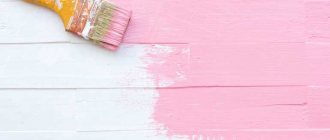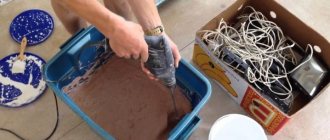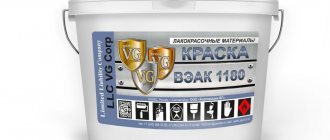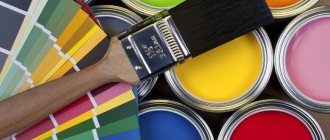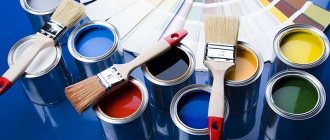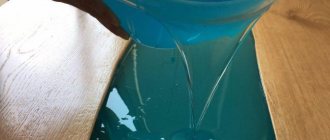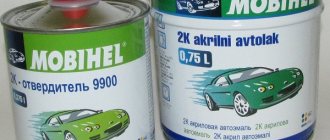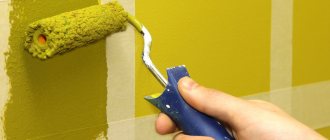How to paint walls with color
To paint walls with color, you do not need to have any special skills. Even a person who has never held a brush in his hands can handle this task. The main task of successful painting is to choose the color to paint the walls. This article will tell you in detail what stages of tinting you need to go through in order for the result to meet your expectations.
What is color
Kohler is a paint that has a particularly rich color. It is used to obtain the required shades of various paints: alkyd, latex, oil, water-dispersed, etc. A wide variety of colors for painting walls allows you to obtain paint of any shade.
Using color
The color is organically used when painting facades and decorating interiors.
Tinting techniques are especially in demand among people with a rich imagination.
The use of color allows you to create complex shades of paint. Such paints are not sold in stores; they cannot be made using a tinting machine. The color is used when added to various paints. It is added to latex, adhesive, and water-dispersed paints.
For example: only by hand can you get the color of currant or orange juice.
How to choose the right color
The color is available in two versions:
- with organic pigments;
- with inorganic pigments.
Color made from natural pigments has a more saturated color, but will quickly deteriorate when exposed to sunlight.
Inorganic color is very resistant to fading, but has a less saturated color and a small color gamut. There are specifics to choosing paint for a room.
As a rule, the color comes in the form of:
- powders;
- solutions;
- pasta.
The best way to select colors for painting walls is to do it yourself. It will be cheaper, and you can get the color you planned. By manually preparing the paint, you have a wider range of colors for the walls.
You can entrust the selection of colors for the walls to a special machine. They are available in large hardware stores. However, the resulting paint may not provide accurate color reproduction.
Facade painting
Thanks to the availability of a variety of shades and the ability to make them yourself, home owners are trying to add more variety when decorating the exterior of a building. In most cases, façade paint is tinted using a computer method, due to the large working area. You can get the desired tone quite quickly by selecting it using a special table.
Painted facades have a beautiful and aesthetic appearance, and the use of color makes water-based paints brighter. In addition, such painting protects the facade from negative environmental factors.
Mixing technique
Before you start tinting, it is worth determining how much color and paint you will need. When preparing by hand, it is difficult to get the same color the second time as the first time. To avoid such moments, calculations are made and exact proportions are determined.
To avoid spoiling all the material, first mix a test color. 100 ml of paint and a few drops of pigment are added to a small container. It is better to dose with a special syringe: this will help you find out the exact amount. Color should be added until the desired shade appears.
What is needed for tinting
Water-based paint is very popular among painting materials. In this regard, colors for water-based paint or other paintwork materials are becoming popular, as an addition that can change the original white color to a delicate color scheme. For tinting, the following factors are taken into account:
- It is calculated how much color can be used for the required area of painting. There is no specific proportion. Everything is done in a way that will be convenient for the person doing the repairs. However, you should start diluting the water-based paint by adding a few drops of dye, slightly changing the white color of the water-based paint to a tone close to the selected color. If a darker shade is required, add a few more drops. For an example of calculation, the following steps can be given:
- 5 drops of coloring composition were used per 100 ml of paint.
40 drops are used per 1000 ml of paint.
- The technology for selecting the desired color is as follows:
- Take several small, clean, wide plastic packages. Yogurt molds are suitable. The main white coating composition is poured into them.
- Then a different number of drops is added to each mold and it is seen what the result is in each option. In order not to get confused, you can stick a “homemade instruction” on each form indicating how much of the main composition and drops of color it contains. It is easiest to work with liquid dye. Powders and pastes are easier to use for larger containers.
- You should review the tinting catalogs of the selected manufacturer. Find the right color, study the corresponding shades.
- If you want to mix several tones to achieve a complex color, you need to carefully study the mixing tables and provide the final shades.
- Don't paint a bucket right away. To see what happens in the end, a probe is pointed in a small container. The resulting paint is applied to a small selected area of the surface to be painted. After it dries, it will be clear what the entire surface will look like.
Adding color to a larger volume of paint occurs with a decrease.
Color chart for choosing a shade
Features of choice
Creating paint of the desired color is a rather specific task, difficult for an inexperienced master. When solving it, existing standards cannot be ignored. They are expressed as percentages:
- In oil-based paints, the amount of color should not exceed 15%.
- In water-based paints, its share should not exceed 20%.
- In other types of base, the amount of color should not be more than 7%.
By choosing a paste, you can reduce the percentage of color and get a bright, rich tone. But liquid color for water-based paint is not able to provide intense coloring. The color after mixing with a white base always turns out muted. This must be taken into account when choosing the type of supplement.
New products appear on the market every year. Today the range includes colors for façade paints (they increase resistance to ultraviolet radiation and precipitation), there are special systems (for signal paints, for compositions intended for interior decoration of medical and educational institutions).
Signal (luminous) paints
It’s difficult to say unequivocally which is better: a paste or a concentrated solution. Each has its own specifics. It is related to the method of tinting the paint. It is more difficult to work with pastes: you have to independently, by trial and error, gradually add a small amount of color to the base composition, and in this way look for the desired color.
The use of ready-made solutions is much simpler: Each corresponds to a specific shade in the color atlas. You can, based on the map, select the desired tone and mix it with the basic white composition. After which the paint is completely ready for use.
Tinting systems
To choose the right tone and, accordingly, achieve a perfectly even color, it is recommended to use tinting mixtures. They are a mixture of base paint (usually white) and a coloring composition - tint. The latter are characterized by a contrasting, often saturated tone compared to that used in the base.
Colorant pigments are divided into two types based on origin:
- organic;
- inorganic.
Pigments of the first type are a range of bright tones. It should be remembered that paints and varnishes obtained from them begin to lose their brightness and saturation over time when exposed to direct sunlight. Therefore, pigments of organic origin are not the best choice for facade paint.
Inorganic pigments are more resistant to aggressive external factors, including fading. However, this paint color has an extremely narrow range of shades.
Colorants are produced in three states:
- dye;
- paste;
- dry composition.
Pastes contain dispersing resins and may not contain a binder.
In terms of their range of applications, pastes can be universal - they can be combined with any type of paint and varnish materials (alkyd enamels, water-based compositions, etc.), as well as highly specialized ones.
The advantage of pastes is their ease of use, as well as the ability to make adjustments to the shade as they mix. However, the disadvantage is the high probability that the color intensity of the tinting paste will be uneven.
The composition of tinting paint contains the same components as in paint and varnish material. This should be taken into account when selecting. For example, if you plan to use water-based paint, then you should choose a color that is identical in composition. By combining white paint and this kind of pigments, you can get any colors. The best combination can be found in a special tinting table. You can change the tone saturation towards brightness by using the colorant in undiluted, pure form.
Dry or loose pigments are inexpensive. But against this background, they have several disadvantages:
- limited choice of colors;
- the shade is difficult to adjust due to the undesirability of adding it to the finished paint.
How to choose
When choosing coatings, you can pay attention to the products of both foreign and domestic manufacturers. The latter offer good quality materials at reasonable prices. It is only necessary to check the shelf life of the product and the compatibility of various materials with each other.
When selecting a pigment for walls, pay attention to the fact that when drying, the tone may turn out to be somewhat paler than on the packaging. Therefore, its consumption may increase compared to what was originally expected. To facilitate the choice, each company has its own table of proposed shades.
How to properly dilute?
The process of mixing color is an important step when painting. For the best result, the following technology must be followed:
- You need to dilute the color in a clean container, for example, take a plastic or enamel bucket.
- Pour a small amount of paint into the container.
- Place it carefully with a mixer or by hand. You may need to add a thinner appropriate to your paint type. Stir until it reaches the consistency of milk.
- Prepare a tinting solution. It consists of 100 g of paint and the necessary (for the total volume) color scheme. Mix the solution until the color is uniform.
- In small portions and stirring constantly, pour the solution into the main volume of paint.
- If foam forms during stirring, it is necessary to let the composition settle until it disappears.
We invite you to watch a video on how to properly dilute paint for tinting walls:
Additional recommendations
To know how to tint paint correctly, it is important to read the instructions and follow all the rules. When manually tinting, it is worth remembering that the result obtained is quite difficult to repeat, so you need to correctly calculate the amount of paint and color consumption. Knowing the area of the room, you can calculate the consumption figure, then you still need to add 10% to it, so the solution should definitely be enough.
It is better to carry out coloring in one container, since there is a considerable probability that in two containers, even when using the same amount of paint and color, compositions of different shades can be obtained.
If we talk about what a paint color is, this is a great way to implement bold and unusual design solutions. These wall paints can be used in interior and exterior applications. For high quality coloring, paint and color must be selected from the same brand.
All the nuances in tinting paints (1 video)
Colors and paints (34 photos)
How to choose?
Let's consider how best to choose the appropriate color scheme and what you need to focus on. Selection criteria taking into account characteristics:
- Manufacturer . Despite prejudices, a domestic manufacturer can offer a product that is no different in quality from a foreign one. And its price will be significantly lower. If the base paint has already been purchased, then it is advisable to take the color from the same company.
- Tara . It is more convenient to use packaging with a narrow neck, this makes it much easier to pour the required volume.
- Type of base paint . The most popular option is for water-based emulsion. This doesn't mean there aren't options for other foundations. But finding them on the market will not be easy.
- Availability of shade map . Almost every manufacturer has such brochures; it is much easier to select the desired shade from them. It is better to check with the seller when purchasing whether such a card is available.
- Hue . Depending on the lighting, the finished shade may look different in different rooms. The recommendation is not to mix the entire volume of the base at once, give it time to “get used to” the shade and make possible adjustments.
- Pigment type . They are organic and synthetic. For a well-lit room, it is better to choose a product with a synthetic pigment, as it is less susceptible to fading in the sun. Under artificial lighting, organic pigment looks better: it is more saturated and has natural, “pure” colors.
Shade selection
When choosing the desired paint shade, there is a whole group of factors to consider. Paint can look very different during the first test strokes and when the entire surface of the walls is already painted.
Lighting also has a significant impact on color perception. Light that is too bright can visually fade bright colors. At dusk or in low light they will appear duller and gloomier. Warm or cool lamp light can make the paint yellow or blue, respectively.
When selecting the desired color using a paint tinting spreadsheet, it is important to remember that even monitors with good resolution and color display will not be able to 100% accurately convey the real shade of paint.
When choosing wall colors for a living space, it is better to give preference to softer and calmer shades. The kitchen and hallway can be painted in brighter and richer colors.
Types and colors
The composition of dyes divides them into organic or inorganic. In the first case, brighter and more saturated shades are guaranteed, but in the future this coating is subject to fading. Inorganic colors have a narrower range of colors, but are considered stable. They have good resistance to weathering, as well as resistance to ultraviolet radiation. The color is produced in various forms:
- tinting pastes;
- dry mixes;
- liquids.
Pay attention to: Water-based paint - purpose, advantages, application
At home, tinting tubes with a liquid composition are often used. It’s easier for them to dilute the paint and set how many drops are needed per bucket. The colors are shown in the color catalogue. The number of tones can reach almost two thousand. When going to a store or market to buy a color scheme, you need to find out in advance what color the surfaces will be painted so that the search for a tone does not take too long. There will be no problems finding the main white paint color. White water-based paint can be purchased at your nearest construction market or store at any time. The color can be selected at the same retail outlet. These materials are always sold in one department. One color can be used to obtain several color schemes for a sample, similar in color, but different in saturation. You can paint, for example, a dark green color. Make it darker or lighter. It all depends on the volume of the bottle’s contents added to the water emulsion. You can combine similar shades.
Color paste
Dry tinting mixture
Liquid color
Color for water-based paint
Water-based paint for walls and ceilings
- Author: Larisa Semenovna Guzeeva
- 5
- 4
- 3
- 2
- 1
(4 votes, average: 3.8 out of 5) Share with your friends!

